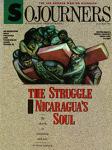Winston Churchill's metaphorical Iron Curtain between East and West may be lifting in these days of glasnost, detente, and other foreign phrases. But there is another Iron Curtain that is holding stronger than ever. That is the one between the American people and their secret government. That's the only substantive lesson to be drawn thus far from the long-awaited criminal trial of Lt. Col. Oliver North.
For the longest while there, it looked as if there might be no trial at all for the former national hero. At every step of the way, the proceedings have been held hostage by the folks in the White House and the "intelligence community" who control the classified information necessary to the conduct of the trial. Reagan, Bush, and their spies have masterfully used the power of information to subvert the principles of democratic governance and an independent judiciary.
First the process of review and declassification of documents dragged on just long enough to preclude the possibility of a trial before last November's elections. Then, in January, the administration's refusal to declassify information forced the prosecutor to drop the most serious and far-reaching charges against North. These were the conspiracy and theft charges that would have been used in court to lay out the known scope of the North-Casey-Secord "Enterprise" and its operations in Iran and Central America.
Finally, in February, after a jury was selected and the trial set to begin, the Bush administration rushed in with last-minute restrictions on the use of classified information which threatened to derail the proceedings entirely. At this writing, in mid-March, the North trial limps onward as a mere shadow of what should have been.
Most of the charges remaining against North are fairly petty matters from the periphery of the Enterprise operations--such as the free home-security system and the pilfered traveler's checks. Only the charge of lying to Congress begins to touch on the larger political and constitutional nature of North's crimes. The prosecution has begun with that count. And not surprisingly, it is that testimony which has provoked the administration to the judicial equivalent of guerrilla warfare.
Like his predecessor, Bush fears the political consequences of stopping the North trial, or pardoning the hero. But he fears a free and open public inquiry even more. Bush has reason to be afraid. Investigations of the Iran-contra affair revealed a strong trail of circumstantial evidence leading to his office door, though the then-vice president remained mysteriously unscathed. There is also the matter of institutional loyalties to be considered. Bush is, after all, also the former director of the CIA.
Weighing all these factors, Bush has settled on a course that his illustrious Republican predecessor, that born-again elder statesman Richard Nixon, once called the "modified, limited hang-out." In Watergate lingo that was a strategy somewhere between a "stonewall" and "letting it all hang out." In current terms that means you have the trial, but only if you can stage-manage it.
The result of this elaborate charade is predictable. The true story of the Enterprise will lie entombed in a vault somewhere in the greater Washington area. It will reside with all the other (suspected) untold stories of the Reagan administration, such as the October 1980 backdoor hostage deal with Iran and the fishy business about Noriega.
WHAT IS SURPRISING, in this post-Watergate age, about the anti-climactic denouement of the Iran-contra scandal is the "see-no-evil" attitude of the establishment media. You might think that media antennae would by now be hypersensitive to the manipulation of classified information, especially when it is virtually the first official act of the first CIA president. But you would be wrong. Thus far the media are playing their part as loyal servants to the state of secrecy.
The extremely high risks of an unaccountable state were dramatically revealed by a 26-year-old piece of news that finally surfaced on February 15, just as the North show trial was getting started. On that day The Boston Globe reported on a newly declassified document about the 1962 Cuban missile crisis.
The document, a report authored by Adm. Robert L. Dennison in April 1963, revealed that a week before the discovery of Soviet missiles in Cuba the United States was in fact preparing for a massive air strike and/or invasion against Cuba. The aircraft and supplies were in position and the troops were at final readiness as early as October 8, 1962. The missiles were first discovered in aerial photographs on October 15, 1962.
The Dennison report was revealed by Graham Allison, dean of Harvard's Kennedy School of Government and a student of the missile crisis. Allison, who also served as a consultant to Caspar Weinberger in the Reagan years, called the document's revelations "shocking."
What shocked Allison was the fact that the planned action against Cuba had nothing to do with the missiles but instead appears to have been part of Operation Mongoose, the Kennedy administration's secret war to overthrow the Castro government. In 1962, Castro and Khrushchev claimed that the missiles were in Cuba to defend against an imminent U.S. attack. Kennedy and his advisers denied having any such plans and proceeded to bring the world to the brink of nuclear war, supposedly to get the missiles out of Cuba.
It now looks as if Castro and Khrushchev, while still holding no moral high ground, did at least have their facts straight. It also appears that the United States government was ready to wage nuclear war to keep from revealing a covert action.
That story should have run at the top of every newspaper and newscast in America. A good headline would have been, "We Won't Get Fooled Again." But it didn't. And we probably will.
Danny Duncan Collum was a Sojourners contributing editor when this article appeared.

Got something to say about what you're reading? We value your feedback!
